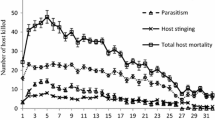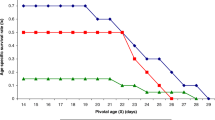Abstract
The endoparasitic development ofG. liparidis was examined in 3 different host stages of gypsy moth larvae. Hatching ofG. liparidis-larvae occurred 3 to 5 days after oviposition in hosts parasitized during their premoulting period, and after 5 to 7 days in those parasitized in the 3rd midinstar state. The parasites generally moulted to the 2nd larval instar between the 11th and 13th day in the first group, and between the 13th and 15th day in the latter, when they had reached a volume of 0.04–0.05 mm3. The positive correlation between host ecdysis and the ecdysis of 1st stadium larvae to L2 suggested that host moulting influenced the development of the parasitoid larvae. Emergence from the host larvae occurred at 20°C after 27 days on average, and coincided with the parasites moulting to the 3rd instar. Five to 7 days after spinning their cocoons near the developmentally arrested host larva, the male, and 1 to 2 days later the female wasps eclosed. Due to the variation in the number of parasites per host, no difference was observed between the hosts parasitized at various stages; however, a tendency for later parasitized hosts to contain more parasite larvae was evident. The nutritional conditions of the moth parental generation influenced both host and parasite development. On the other hand no influence of host age was observed on emergence dates of larvae and wasps.
Zusammenfassung
Die endoparasitische Entwicklung vonG. liparidis wurde an drei Raupentypen vonLymantria dispar untersucht, die in verschiedenen Stadien parasitiert worden waren (A-Raupen: Vorhäutung L1/L2; B-Raupen: Vorhäutung L2/L3; C-Raupen: Mitte L3).
Das Schlüpfen der Parasitenlarven aus den Eiern fand bei den A- und B-Raupen hauptsächlich zwischen dem 3. und 5. Tag nach dem Anstich, bei den C-Raupen zwischen dem 5. und 7. Tag statt. Nach 11–13 Tagen, wenn die Parasitenlarven in den A- und B-Raupen ein Volumen vonca. 0.04–0.05 mm3 erreicht hatten, häuteten sie sich zum zweiten Stadium. Auch in diesem Fall benötigten die Parasitenlarven in den C-Raupen für die Häutung durchschnittlich zwei Tage länger. Aus dem Zusammenhang zwischen der Anzahl frischgehäuteter Wirtsraupen und der Entwicklung von L2-Parasitenlarven ist zu vermuten, daß die Häutung vonG. liparidis-Larven nicht nur von ihrem Wachstum, sondern auch von den Häutungsvorgängen ihrer Wirtsraupen beeinflußt wird.
Die stärkste Volumenszunahme der Parasitenlarven war zwischen dem 17. und 19. Tag nach dem Anstich zu beobachten, kurz bevor die Vorhäutungsphase zur L3 einsetzte. Während des Auskriechens, das bei A-Raupen frühestens am 18. Tag, bei B- und C-Raupen 3–4 Tage später stattfand, häuteten sich die Parasitenlarven zur L3 und begannen sogleich mit der Anfertigung ihrer Kokons in unmittelbarer Nähe der Wirtsraupe. Ein Unterschied zwischen den drei Raupentypen bezüglich des durchschnittlichen Ausborhtermins der Parasitenlarver (27 Tage nach dem Anstich) bzw. des Schlüpftermins der adulten Wespen (34–37 Tage) konnte nicht festgestellt werden.
Ebenso konnte aufgrund der großen Variabilität kein Unterschied in der durchschnittlichen Anzahl der Parasitenlarven pro Wirt (\(\bar x = 9\)) zwischen den untersuchten Raupentypen nachgewiesen werden. Jedoch war der Prozentsatz an Raupen, die mehr als 20 Parasiten/Wirt aufwiesen, bei den C-Raupen deutlich höher als bei den A- und B-Raupen. Die Parasitendichte im Bereich von 2 bis 30 Parasitenlarven pro Wirt hatte dagegen keine Einfluß auf den Auskriechtermin der Larven.
Eine bedeutende Rolle, sowohl für die Entwicklung der Wirtsraupe als auch für die der Parasitenlarven, spielten die Ernährungsbedingungen der Elterngeneration des Schwammspinners.
Résumé
Le développement endoparasitaire deG. liparidis a été examiné dans 3 stades-hôtes différents des larves deLymantria. L'éclosion des larves deG. liparidis se produisait 3 à 5 jours après l'oviposition dans les hôtes parasités durant la période précédant la mue et après 5 à 7 jours dans ceux parasités au milieu de leur troisième stade. Les parasites muaient généralement au 2e stade larvaire, entre le 11e et le 13e jour dans le premier groupe, entre le 13e et le 15e jour dans l'autre quand ils ont atteint un volume de 0,04–0,05 mm3. La corrélation positive entre la mue de l'hôte et celle du stade larvaire en L2 suggérait que la mue de l'hôte influençait le développement de la larve du parasitoïde. L'émergence de la larve-hôte avait lieu à 20°C après 27 jours en moyenne et coïncidait avec la mue des parasites au 3e stade larvaire. Cinq à sept jours après le tissage de leurs cocons, les hyménoptères mâles et un à deux jours plus tard, les femelles, éclosaient. Du fait de la variation du nombre de parasites par hôte, on n'observait pas de différence entre les hôtes parasités à des stades variés; cependant, la tendance pour les hôtes parasités tardivement à contenir plus de larves de parasites était manifeste.
Les conditions alimentaires de la génération des parents deLymantria influençaient le développement à la fois de l'hôte et du parasite.
Similar content being viewed by others
References
Beckage, N. E. &Riddiford, L. M. — 1978. Developmental interactions between the tobacco hornwormManduca sexta and its braconid parasiteApanteles congregatus. —Entomol. Exp. Appl., 23, 139–151.
Beckage, N. E. &Riddiford, L. M. — 1983. Growth and development of the endoparasitic waspApanteles congregatus: dependence on host nutritional status and parasite load. —Physiol. Entomol., 8, 231–241.
Bell, R. A., Owens, C. D., Shapiro, M. & Tardif, J. R. — 1981. Development of mass-rearing technology. In: The Gypsy Moth: Research toward integrated pest management. (C. C. Doane & M. L. McManus, eds.). —U.S. Dept. Agric., Tech. Bull., 1584, 599–633.
Burgess, A. F. & Crossman, S. S. — 1929. Imported insect enemies of the gypsy moth and the brown-tail moth. —U.S. Dep. t. Agric. Tech. Bull., 86, 147 pp.
Capinera, J. L., Barbosa, P. &Hagedorn, H. H. — 1977. Yolk and yolk depletion of gypsy moth eggs: implications for population quality. —Ann. Entomol. Soc. Am., 70, 40–42.
Fuester, R. W., Drea, J. J. Gruber, F., Hoyer, H. &Mercadier, G. — 1983. Larval parasites and other natural enemies ofLymantria dispar [Lepidoptera: Lymantriidae] in Burgenland, Austria, and Würzburg, Germany. —Environ. Entomol., 12, 724–737.
Führer, E. &Keja, T. D. — 1976. Physiologische Wechselbeziehungen zwischenPieris brassicae und dem EndoparasitenApanteles glomeratus. Der Einfluß der Parasitierung auf Wachstum und Körpergewicht des Wirtes. —Entomol. Exp. Appl., 19 287–300.
Fukuya, S. — 1938. Effect of temperature and humidity upon the development ofApanteles liparidis Bouché and its parasites. —Oyo Dobuts Zassh., 10, 234–244.
Fusco, R. A. — 1981.Apanteles liparidis (Bouché). In: The Gypsy Moth: Research toward integrated pest management. (C. C. Doane & M. L. McManus, eds.). — U.S. Dept. Agric., Tech. Bull., 1584, 366–367.
Greenblatt, J. A., Barbosa, P. &Montgomery, M. E. — 1982. Host's diet effects on nitrogen utilization efficiency for two parasitoid species,Brachymeria intermedia andCoccygomimus turionellae. —Physiol. Entomol., 7, 263–267.
Johannson, A. S. — 1951. Studies on the relation betweenApanteles glomeratus L. [Hym.: Braconidae] andPieris brassicae L. [Lep.: Pieridae]. —Norsk. Entomol. Tidsskr., 8, 145–186.
Jones, D., Jones, G. &Hammock, B. D. — 1981. Developmental and behavioural responses of larvalTrichoplusia ni to parasitization by an imported braconid parasiteChelonus sp. —Physiol. Entomol., 6, 387–394.
Mackauer, M. — 1986. Growth and developmental interactions in some aphids and their hymenopterous parasites. —J. Insect Physiol., 32, 275–280.
Nijhout, H. F. — 1981. Physiological control of moulting in insects. —Am. Zool., 21, 631–640.
Sato, Y. — 1980. Experimental studies on parasitization byApanteles glomeratus. V. Relationships between growth rate of parasitoid and host age at the time of oviposition. —Annu. Rev. Entomol., 26, 183–211.
Slansky, F., Jr. — 1986. Nutritional ecology of endoparasitic insects and their hosts: an overview. —J. Insect Physiol., 32, 255–261.
Tagawa, J., Sato, Y. &Tanaka, T. — 1982. Developmental interactions between the armywormLeucania separata [Lep.: Noctuidae] and its parasiteApanteles ruficrus [Hym.: Braconidae]. —Entomophaga, 27, 447–454.
Thompson, S. N. — 1981. Effects of dietary carbohydrate and lipid on nutrition and metabolism of metazoan parasites with special reference to parasitic Hymenoptera. In: Current Topics in Insect Endocrinology and Nutrition. (G. Bhaskaran, Friedman, S. &J. G. Rodriguez, eds.). —Plenum Press, New York, 215–252 pp.
Ticehurst, M. &Fusco, R. A. — 1976. Release of threeApanteles spp. against the gypsy moth in Pennsylvania. —J. Econ. Entomol., 69, 307–308.
Vinson, S. B. &Iwantsch, G. F. — 1980. Host suitability for insect parasitoids. —Annu. Rev. Entomol., 25, 397–419.
Wilkinson, D. S. — 1945. Description of palearctic species ofApanteles [Hym.: Braconidae]. —Trans. R. Entomol. Soc. Lon., 93, Part 3, 35–226.
Author information
Authors and Affiliations
Rights and permissions
About this article
Cite this article
Schopf, A. The effect of host age ofLymantria dispar larvae [Lep.: Lymantriidae] on the development ofGlyptapanteles liparidis [Hym.: Braconidae] . Entomophaga 36, 593–604 (1991). https://doi.org/10.1007/BF02374442
Received:
Accepted:
Issue Date:
DOI: https://doi.org/10.1007/BF02374442




